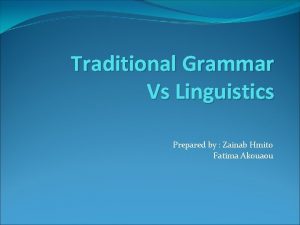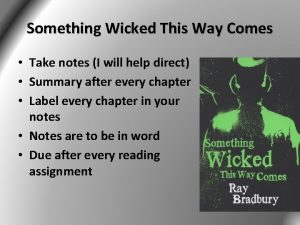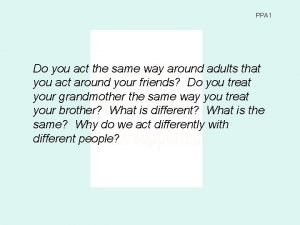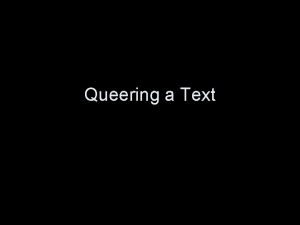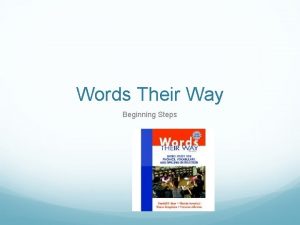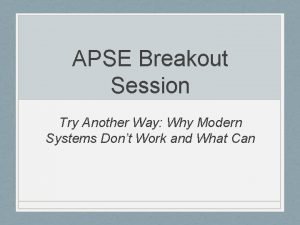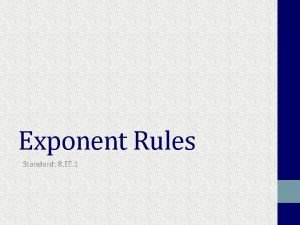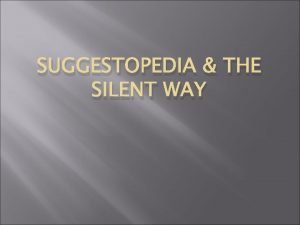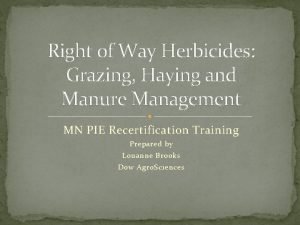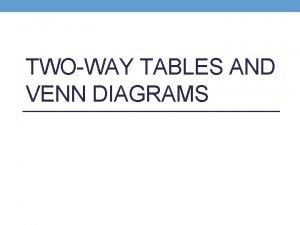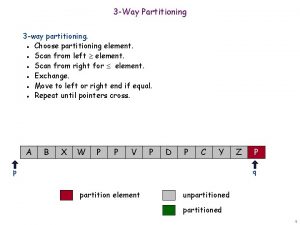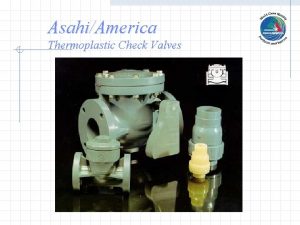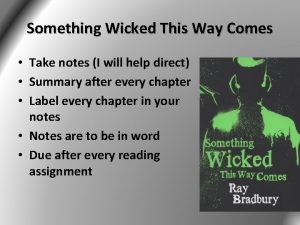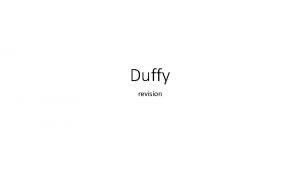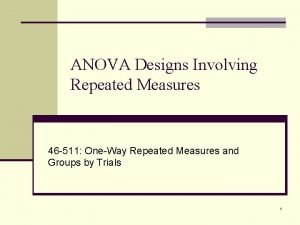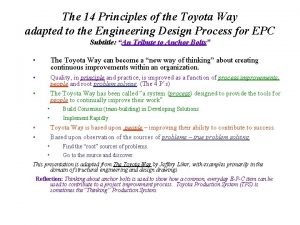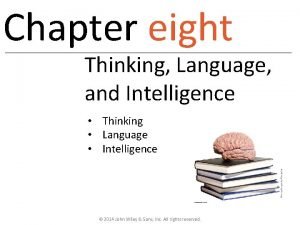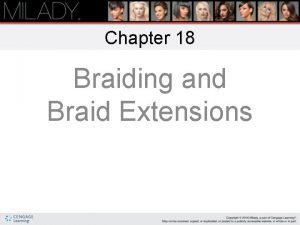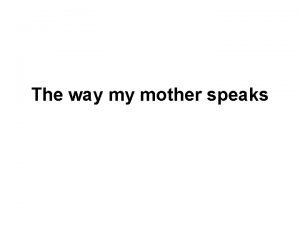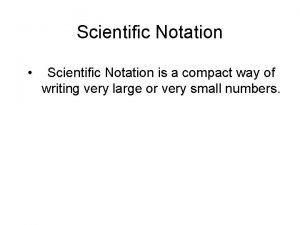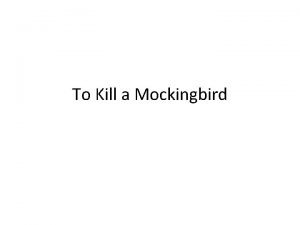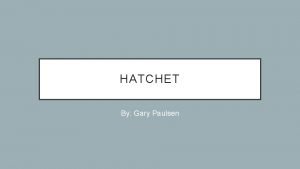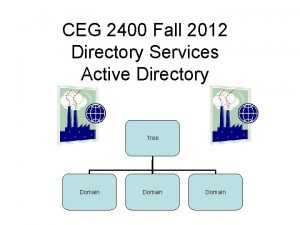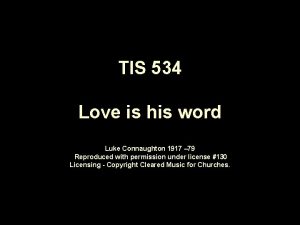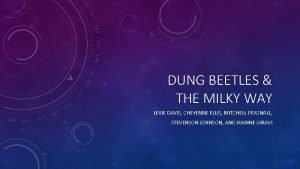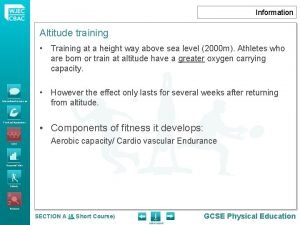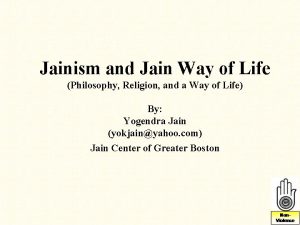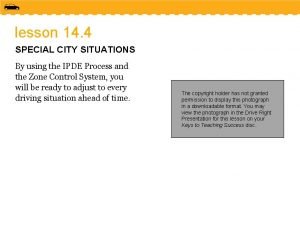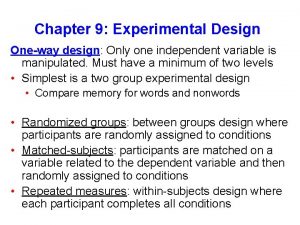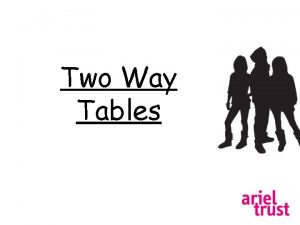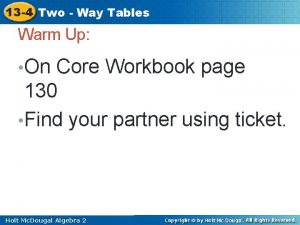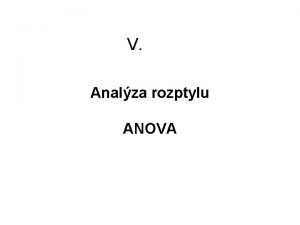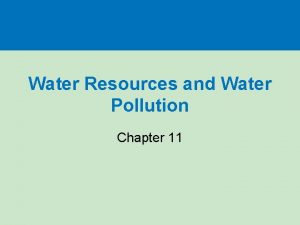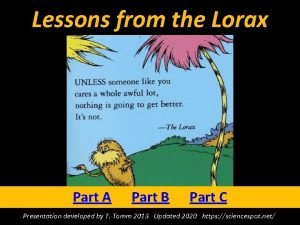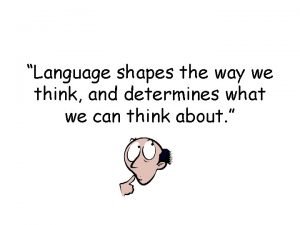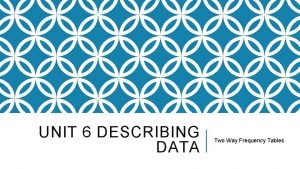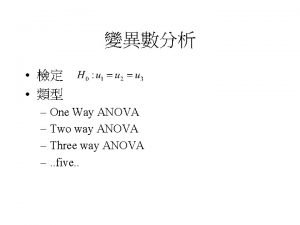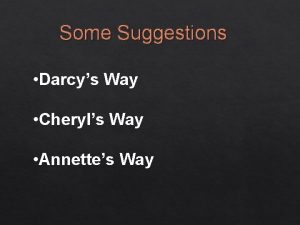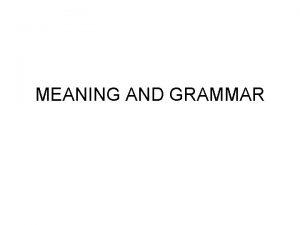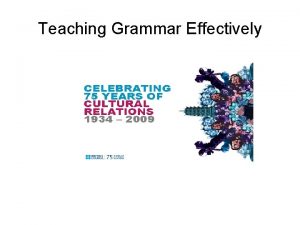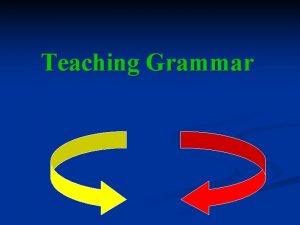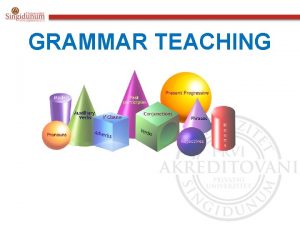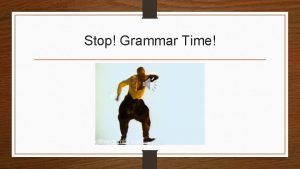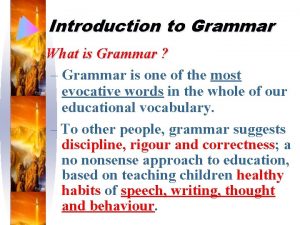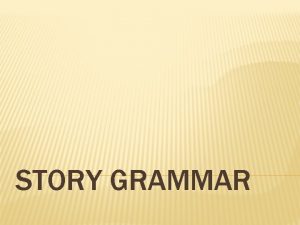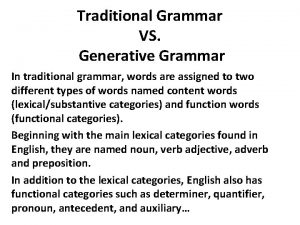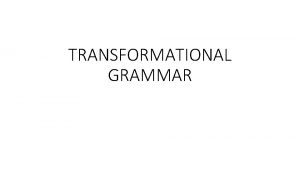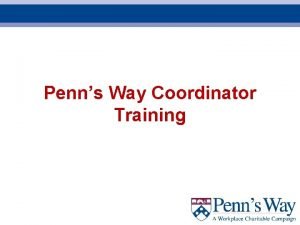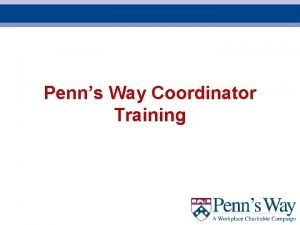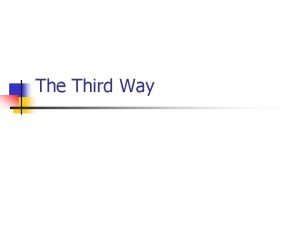WHAT IS GRAMMAR Grammar is a way of
































































- Slides: 64

WHAT IS GRAMMAR? Grammar is a way of thinking about language. Please get used to this response… We will discuss this every time we work on grammar!

FOUR-LEVEL ANALYSIS SYSTEM Begins with comprehensive lectures on the four levels of traditional grammar, followed by cumulative reviews, applications, and appreciations of grammar 1. Parts of Speech 2. Parts of a Sentence 3. Phrases 4. Clauses

FOUR-LEVEL ANALYSIS SYSTEM We read a book by John Steinbeck. Parts Of Speech Parts of Sentence Pro. Verb Art. Noun. Prep. Prop. Noun _____________________________ Subj. Verb Direct Object _____________________________ -------Prep. Phrase------ Phrases _____________________________ One clause, a simple declarative sentence Clauses _____________________________

FOUR-LEVEL ANALYSIS SYSTEM Advantages to this System: § Disconnected experiences are replaced by 4 -level analysis § Grammar is explained in terms of SYSTEMS § Patterns are emphasized § ONCE YOU FIGURE OUT HOW TO USE THE SYSTEM, YOU’RE GOLDEN!

LEVEL ONE: PARTS OF SPEECH Level One: Parts of Speech

NOUNS Definition: the name of a person, place, thing, or idea Job: must be either subjects or objects; they think they’re in control.

NOUNS ARE EITHER SUBJECTS OBJECTS

PRONOUNS Definition: a word that takes the place of a noun. Job: by definition, it must be either a subject or an object.

PRONOUNS ARE EITHER SUBJECTS OBJECTS

ADJECTIVES Definition: a word that modifies (or describes) a noun or pronoun. Job: answers the questions, “What kind? ”, “Which one? ”, or “How many? ”

WHAT INFORMATION DOES IT GIVE YOU? ADJECTIVES ANSWER THE QUESTIONS: 1. What kind? 2. Which One? 3. How Many? Magic Lens considers “a” “the” “an” adjectives instead of articles

VERBS Definition: a word that shows action or state of being Job: either linking or action verbs

VERBS ARE EITHER LINKING ACTION

ADVERBS Definition: a word that modifies (or describes) a verb, adjective, or another adverb. Job: answers the questions: Where, When, Why, How, To what extent?

WHAT INFORMATION DOES IT GIVE YOU? ADVERBS ANSWER THE QUESTIONS: 1. Where? 2. When? 3. Why? 4. How? 5. To what extent?

CONJUNCTIONS Definition: a word that joins two words or groups of words. Job: either coordinating or subordinating

WHAT INFORMATION DOES IT GIVE YOU? Most Common Conjunctions: 1. For 2. And 3. Nor 4. But 5. Or 6. Yet 7. So

PREPOSITIONS Definition: a word that shows the relationship between words or objects. Job: introduces a phrase & serves as an adjective or adverb

INTERJECTIONS Definition: a word that shows emotion but has no grammatical function Job: None!

LEVEL TWO: PARTS OF A SENTENCE (SENTENCE PATTERNS) Level Two: Parts of a Sentence (Patterns)

TO CLEARLY UNDERSTAND A SENTENCE, IT MUST BE A COMPLETE SENTENCE These 6 sentence patterns will help you determine if it’s a complete sentence

6 PATTERNS OF A SENTENCE While we have 8 Parts of Speech, we only have 6 different sentence patterns. Sentence Parts: Complete sentences are made up of a # SUBJECT and a # PREDICATE

2 PARTS OF A SENTENCE SUBJECT - Names the “do-er” or “be-er” of the sentence (Who/What is verbing? ) - Also includes any modifying words or phrases (such as adj. ) “The cat in the hat comes back. ” PREDICATE - Begins with the verb and does the rest of the work in the sentence. “The cat in the hat comes back. ”

Subject / Verb (S+V) Verb can either be action or linking Example: “Kate screamed. ”

DIFFERENCE BETWEEN LINKING AND ACTION VERBS Linking Is Am Are Was Were Seems Becomes Feels Appears Been being Action Run Jump Sing Dance ACTION!

Subject / Linking Verb / Predicate Noun (S+LV+PN) PN follows the LV and tells us what the subject is. Examples: “I am a teacher. ” (teacher = PN) “Mr. Urban is a principal at FHS. ”

Subject / Linking Verb / Predicate Adjective (S+LV+PA) Predicate adjective: follows the LV and tells us something about the subject. Examples: “I am happy. ” (happy = PA) “The game on Friday was ridiculous. ”

Subject / Action Verb / Direct Object (S+AV+DO) Direct Object: receives action in a sentence (is acted upon by the verb). It is a noun (answers who or what) Examples: “David lost the money. ” “Bilbo carried the ring. ” (money = DO)

Subject / Action Verb / Indirect Object / Direct Object (S+AV+IO+DO) Indirect object: to/for whom OR to/for what the action is performed. It is a different noun than the DO. Examples: “David gave me the money. ” (me = IO) “Bilbo gave Frodo the ring. ”

Subject / Action Verb / Direct Object / Object Complement (S+AV+DO+OC) Object Complement: renames or describes the DO – can be an adj. or noun (it only modifies the DO…if not, it’s not OC) Examples: “Her generosity made me happy. ” “She cut the cake for her birthday”

TODAY IS OCTOBER 1, 2015 Please have your device out, a piece of paper and a writing utensil.

LEVEL THREE: PHRASES Level Three: Phrases

5 TYPES OF PHRASES 8 Parts of Speech 6 Parts of a Sentence 5 Types of Phrases PHRASES: § a group of words § without a subject or predicate § functions as a single part of speech

5 TYPES OF PHRASES - These are examples of phrases. 8 Parts of Speech - When used alone in writing, they are 6 Parts of a Sentence called sentence fragments. 5 Types of Phrases PHRASES: § a group of words § without a subject or predicate § functions as a single part of speech

Prepositional Phrase (1) Show relationship & include everything between prep. & and the object of the prep. (obj. can be a noun or a pronoun) (2) Adjective OR adverb Example: “The cat with the short tail ran into the house. ” (with the short tail) (into the house)

Appositive Phrase (1) Identifies a noun/pronoun that is already in the sentence (2) Noun phrase – who/what Example: “FHS, the best school in the state, is celebrating homecoming this week. ”

GERUNDS (1) Ends in –ing and names activities (2) Noun *HINT: you can substitute “it” or “the activity” and it’s still grammatically correct* Example: “I like running. ” (the activity of running) “I enjoy climbing tall mountains. ”

PARTICIPLES (1) Ends in –ing OR –ed and are used to describe (2) Function as adjectives *Can be grammatically removed* Example: “The coughing man sounds really sick” “Loved by many, hated by few, dogs are the most popular pet in the U. S. ”

INFINITIVES (1) Begins with “to” + verb (always!) (2) Nouns, adjectives, or adverbs Example: “To run” = infinitive “To run faster than a bear is a valuable skill. ” (infinitive phrase – funct. as noun) “The plan to release monkeys in the wild has been effective. ” (funct. as an adj)

EXAMPLE SENTENCE #1 WHICH TYPE OF PHRASE DO YOU SEE? To win the game is my goal. INFINITIVE PHRASE: “to” + verb

EXAMPLE SENTENCE #2 WHICH TYPE OF PHRASE DO YOU SEE? She loves receiving presents.

EXAMPLE SENTENCE #2 WHICH TYPE OF PHRASE DO YOU SEE? She loves receiving presents. GERUND PHRASE: ends in “-ing” / can substitute the word “it” for the phrase

EXAMPLE SENTENCE #3 WHICH TYPE OF PHRASE DO YOU SEE? My neighbor enjoys being creepy.

EXAMPLE SENTENCE #3 WHICH TYPE OF PHRASE DO YOU SEE? My neighbor enjoys being creepy. GERUND PHRASE: ends in “-ing” / can substitute the word “it” for the phrase

EXAMPLE SENTENCE #4 WHICH TYPE OF PHRASE DO YOU SEE? Mr. Goodwin scolded Anna, the loudest girl in class.

EXAMPLE SENTENCE #4 WHICH TYPE OF PHRASE DO YOU SEE? Mr. Goodwin scolded Anna, the loudest girl in class. APPOSITIVE PHRASE: identifies a noun (gives more information)

EXAMPLE SENTENCE #5 WHICH TYPE OF PHRASE DO YOU SEE? Dean Miller broke up the fight between the two girls.

EXAMPLE SENTENCE #5 WHICH TYPE OF PHRASE DO YOU SEE? Dean Miller broke up the fight between the two girls. PREPOSITIONAL PHRASE: shows relationship or location

LEVEL FOUR: CLAUSES Level Four: Clauses

2 TYPES OF CLAUSES 8 6 5 2 Parts of Speech Parts of a Sentence Types of Phrases Types of Clauses CLAUSES: § a group of words § contains a subject and a verb

Independent Clause Stands alone as a complete thought with a subject and a predicate. • A single independent clause is a simple sentence Example: “My name is Christina Ripley. ”

Dependent Clause Adds info (such as noun, adjective, or adverb) • It CANNOT stand alone because it uses a SUBORDINATING CONJUNCTION. It requires help from an independent clause to be a grammatical sentence. Example: “Because you are ambitious, you will suffer the consequences. ” (because = SC)

LIST OF SUBORDINATING CONJUNCTIONS after although as because before even if even though if in order once provided that rather than since so that than that though unless until whenever whereas wherever whether while why

EXAMPLE SENTENCE #14 WHICH TYPE OF CLAUSE(S) DO YOU SEE? The boy likes the girl.

EXAMPLE SENTENCE #14 WHICH TYPE OF CLAUSE(S) DO YOU SEE? The boy likes the girl. I-N-D-E-P-E-N-D-E-N-T (do you know what that means? )

EXAMPLE SENTENCE #15 WHICH TYPE OF CLAUSE(S) DO YOU SEE? I went to the store yesterday to buy bread for the old lady across the street.

EXAMPLE SENTENCE #15 WHICH TYPE OF CLAUSE(S) DO YOU SEE? I went to the store yesterday to buy bread for the old lady across the street. I-N-D-E-P-E-N-D-E-N-T (do you know what that means? )

EXAMPLE SENTENCE #16 WHICH TYPE OF CLAUSE(S) DO YOU SEE? Although I prefer lifting weights, I do enjoy doing pushups from time to time.

EXAMPLE SENTENCE #16 WHICH TYPE OF CLAUSE(S) DO YOU SEE? Although I prefer lifting weights, I do enjoy doing pushups from time to time. Dependent / Independent

EXAMPLE SENTENCE #17 WHICH TYPE OF CLAUSE(S) DO YOU SEE? I hate snow because of the shoveling.

EXAMPLE SENTENCE #17 WHICH TYPE OF CLAUSE(S) DO YOU SEE? I hate snow because of the shoveling. Independent / Dependent

EXAMPLE SENTENCE #18* WHICH TYPE OF CLAUSE(S) DO YOU SEE? I like you, and you like me.

EXAMPLE SENTENCE #18* WHICH TYPE OF CLAUSE(S) DO YOU SEE? I like you, and you like me. Independent / Independent

GRAMMAR FOLDER Your folder should have the following handouts to turn in. Parts of speech practice Sentence Patterns practice Phrases Practice Clauses Practice Turn in your folder with only these items.
 Walk this way talk this way
Walk this way talk this way Advantage and disadvantage of threaded binary tree
Advantage and disadvantage of threaded binary tree Pengertian two way anova
Pengertian two way anova Beda one way anova dan two way anova
Beda one way anova dan two way anova Conventional software engineering
Conventional software engineering Marginal frequency
Marginal frequency Anova test
Anova test When i was one i had just begun the day i went to sea
When i was one i had just begun the day i went to sea Perbedaan one way dan two way anova
Perbedaan one way dan two way anova One way anova vs two way anova
One way anova vs two way anova Right linear grammar
Right linear grammar Right linear to left linear grammar
Right linear to left linear grammar What is traditional grammar in linguistics
What is traditional grammar in linguistics Type 0 grammar example
Type 0 grammar example Something wicked this way comes summary
Something wicked this way comes summary Act the same way
Act the same way Foucault friendship as a way of life
Foucault friendship as a way of life The way the economic units are organized
The way the economic units are organized Words their way power score chart
Words their way power score chart Try another way
Try another way What is the short way of writing repeated multiplication
What is the short way of writing repeated multiplication United way of the coalfield
United way of the coalfield One-way functions
One-way functions Two way selection and multiway selection
Two way selection and multiway selection Silent way method activities
Silent way method activities Right of way herbicides
Right of way herbicides Venn diagrams and two way tables
Venn diagrams and two way tables 3-way partitioning
3-way partitioning Gosco s-class
Gosco s-class Something wicked this way comes chapter summary
Something wicked this way comes chapter summary The way my mother speaks
The way my mother speaks What can we learn from studying ancient greek artwork
What can we learn from studying ancient greek artwork Two-way repeated measure anova
Two-way repeated measure anova One way ticket langston hughes analysis
One way ticket langston hughes analysis Toyota way 14 principles
Toyota way 14 principles No way is impossible to courage
No way is impossible to courage Joint frequency vs marginal frequency
Joint frequency vs marginal frequency Chapter 8 thinking language and intelligence
Chapter 8 thinking language and intelligence Preparing textured hair for braiding
Preparing textured hair for braiding The way my mother speaks annotated
The way my mother speaks annotated What is scientific notation
What is scientific notation Why does scout stand up for walter
Why does scout stand up for walter Brian showed ingenuity in this chapter. cite examples
Brian showed ingenuity in this chapter. cite examples Active directory two way trust
Active directory two way trust Way forward presentation
Way forward presentation Richer than gold is the love of my lord
Richer than gold is the love of my lord Sandstone way accommodation
Sandstone way accommodation Fastest way to get a job
Fastest way to get a job Dung beetle milky way
Dung beetle milky way Height way
Height way Archangel way devon
Archangel way devon Jain way of life
Jain way of life If you encounter a vehicle headed the wrong way
If you encounter a vehicle headed the wrong way One way experimental design
One way experimental design Two way tables exam questions
Two way tables exam questions Which way now
Which way now Examples of two way tables
Examples of two way tables Part to part variation
Part to part variation Anova vs. manova
Anova vs. manova Way to reduce water pollution
Way to reduce water pollution Research is a way of thinking
Research is a way of thinking The lorax environmental lesson
The lorax environmental lesson Language determines the way we think
Language determines the way we think Gosco s-class 3-way diverter valves
Gosco s-class 3-way diverter valves Two-way relative frequency tables
Two-way relative frequency tables












